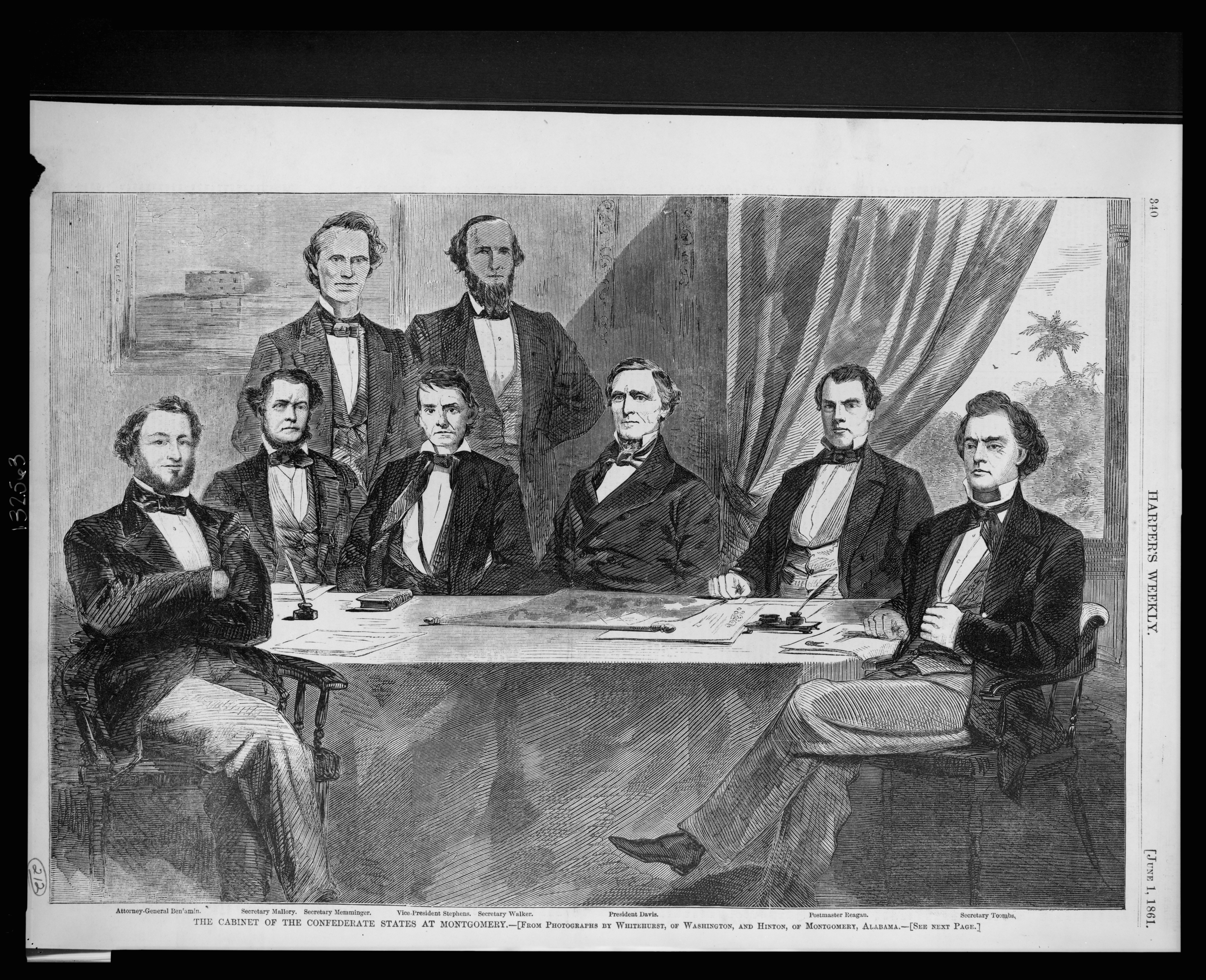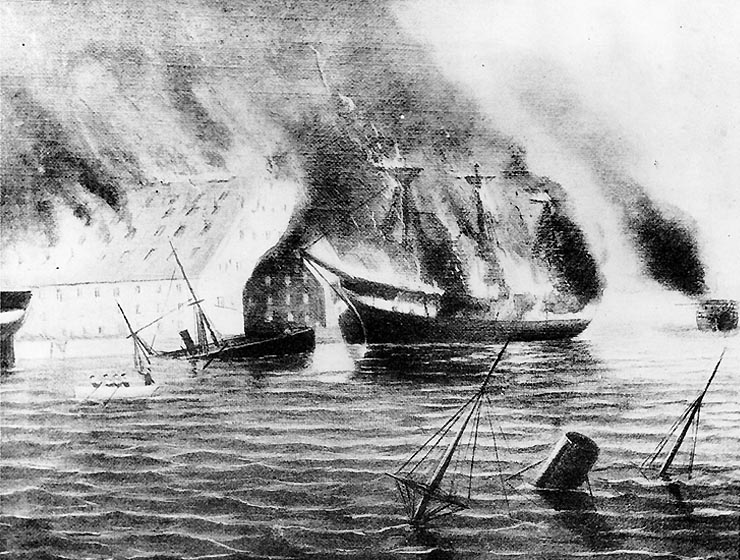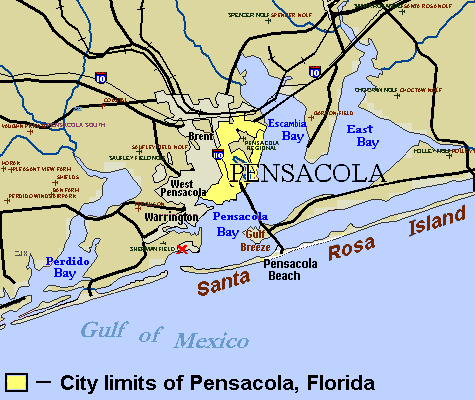|
Confederate Navy
The Confederate States Navy (CSN) was the Navy, naval branch of the Confederate States Armed Forces, established by an act of the Confederate States Congress on February 21, 1861. It was responsible for Confederate naval operations during the American Civil War against the United States's Union Navy. The three major tasks of the Confederate States Navy during its existence were the protection of Confederate harbors and coastlines from outside invasion, making the war costly for the United States by attacking its merchant ships worldwide, and Blockade runners of the American Civil War, running the Union blockade, U.S. blockade by drawing off Union ships in pursuit of Confederate commerce raiders and warships. It was ineffective in these tasks, as the coastal blockade by the United States Navy reduced trade by the South to 5 percent of its pre-war levels. Additionally, the control of inland rivers and coastal navigation by the US Navy forced the south to overload its limited railroa ... [...More Info...] [...Related Items...] OR: [Wikipedia] [Google] [Baidu] |
Navy
A navy, naval force, military maritime fleet, war navy, or maritime force is the military branch, branch of a nation's armed forces principally designated for naval warfare, naval and amphibious warfare; namely, lake-borne, riverine, littoral zone, littoral, or ocean-borne combat operations and related functions. It includes anything conducted by surface Naval ship, ships, amphibious warfare, amphibious ships, submarines, and seaborne naval aviation, aviation, as well as ancillary support, communications, training, and other fields. The strategic offensive role of a navy is Power projection, projection of force into areas beyond a country's shores (for example, to protect Sea lane, sea-lanes, deter or confront piracy, ferry troops, or attack other navies, ports, or shore installations). The strategic defensive purpose of a navy is to frustrate seaborne projection-of-force by enemies. The strategic task of a navy also may incorporate nuclear deterrence by use of submarine-launche ... [...More Info...] [...Related Items...] OR: [Wikipedia] [Google] [Baidu] |
Union Blockade
The Union blockade in the American Civil War was a naval strategy by the United States to prevent the Confederate States of America, Confederacy from trading. The blockade was proclaimed by President Abraham Lincoln in April 1861, and required the monitoring of of Atlantic Ocean, Atlantic and Gulf of Mexico, Gulf coastline, including 12 major ports, notably New Orleans and Mobile, Alabama, Mobile. Those Blockade runners of the American Civil War, blockade runners fast enough to evade the Union Navy could carry only a small fraction of the supplies needed. They were operated largely by British and French citizens, making use of neutral ports such as Havana, Cuba, Havana, Nassau, Bahamas, Nassau and Bermuda. The Union commissioned around 500 ships, which destroyed or captured about 1,500 blockade runners over the course of the war. The blockade was successful in blocking 95% of cotton exports from the South compared to pre-war levels, devaluing its currency and severely damaging ... [...More Info...] [...Related Items...] OR: [Wikipedia] [Google] [Baidu] |
Stephen Mallory
Stephen Russell Mallory (1812 – November 9, 1873) was an American politician who was a United States Senator from Florida from 1851 to the secession of his home state and the outbreak of the American Civil War in 1861. For much of that period, he was chairman of the Committee on Naval Affairs. It was a time of rapid naval reform, and he insisted that the ships of the U.S. Navy should be as capable as those of Britain and France, the foremost navies in the world at that time. He also wrote a bill and guided it through Congress to provide for compulsory retirement of officers who did not meet the standards of the profession. Although he was not a leader in the secession movement, Mallory followed his state out of the Union. When the Confederate States of America was formed, he was named Secretary of the Navy in the administration of President Jefferson Davis. He held the position throughout the existence of the Confederacy. Because of indifference to naval matters by most other ... [...More Info...] [...Related Items...] OR: [Wikipedia] [Google] [Baidu] |
Scuttled
Scuttling is the act of deliberately sinking a ship by allowing water to flow into the hull, typically by its crew opening holes in its hull. Scuttling may be performed to dispose of an abandoned, old, or captured vessel; to prevent the vessel from becoming a navigation hazard; as an act of self-destruction to prevent the ship from being captured by an enemy force; as a blockship to restrict navigation through a channel or within a harbor; to provide an artificial reef for divers and marine life; or to alter the flow of rivers. Notable historical examples Skuldelev ships (around 1070) The Skuldelev ships, five Viking ships, were sunk to prevent attacks from the sea on the Danish city of Roskilde. The scuttling blocked a major waterway, redirecting ships to a smaller one that required considerable local knowledge. Cog near Kampen (early 15th century) In 2012, a cog preserved from the keel up to the decks in the silt was discovered alongside two smaller vessels in t ... [...More Info...] [...Related Items...] OR: [Wikipedia] [Google] [Baidu] |
USS Merrimack (1855)
USS ''Merrimack'', variant spelling ''Merrimac'', was a steam frigate, best known as the hull upon which the ironclad warship CSS ''Virginia'' was constructed during the American Civil War. The CSS ''Virginia'' then took part in the Battle of Hampton Roads (also known as "the Battle of the ''Monitor'' and the ''Merrimack''") in the first engagement between ironclad warships. ''Merrimack'' was the first of six screw frigates (steam frigates powered by screw propellers) begun in 1854. Like others of her class (, , , and ), she was named after a river. The Merrimack originates in New Hampshire and flows through the town of Merrimac, Massachusetts, often considered an older spelling which has sometimes caused confusion of the name.Nelson, J. The Reign of Iron. 2004. After the ship was burned on April 20 1861, it was rebuilt with iron siding in the American Civil War by the Confederacy and renamed the Virginia. History Creation ''Merrimack'' was launched by the Boston ... [...More Info...] [...Related Items...] OR: [Wikipedia] [Google] [Baidu] |
Steam Frigate
Steam frigates (including screw frigates) and the smaller steam corvettes, steam sloops, steam gunboats and steam schooners, were steam-powered warships that were not meant to stand in the line of battle. The first such ships were paddle steamers. Later on the invention of screw propulsion enabled construction of screw-powered versions of the traditional frigates, corvettes, sloops and gunboats. Evolution First steam warships The first small vessel that can be considered a steam warship was the '' Demologos'', which was launched in 1815 for the United States Navy. From the early 1820s, the British Navy began building a number of small steam warships including the armed tugs and , and by the 1830s the navies of America, Russia and France were experimenting with steam-powered warships. Hellenic sloop-of-war '' Kartería'' (Καρτερία; Greek for "Perseverance") was the first steam-powered warship to be used in combat operations in history. It was built in 1825 in an Eng ... [...More Info...] [...Related Items...] OR: [Wikipedia] [Google] [Baidu] |
Pensacola, Florida
Pensacola ( ) is a city in the Florida panhandle in the United States. It is the county seat and only incorporated city, city in Escambia County, Florida, Escambia County. The population was 54,312 at the 2020 United States census, 2020 census. It is the principal city of the Pensacola metropolitan area, which had 509,905 residents in the 2020 census. Pensacola was first settled by the Spanish Empire in 1559, antedating the establishment of St. Augustine, Florida, St. Augustine by six years, but was abandoned due to a significant hurricane and not resettled until 1698. Pensacola is a Port of Pensacola, seaport on Pensacola Bay, which is protected by the barrier island of Santa Rosa Island (Florida), Santa Rosa and connects to the Gulf of Mexico. A large Naval Air Station Pensacola, United States Naval Air Station, the first in the United States, is located in Pensacola. It is the base of the Blue Angels flight-demonstration team and the National Naval Aviation Museum. The Univers ... [...More Info...] [...Related Items...] OR: [Wikipedia] [Google] [Baidu] |
Dry Docks
Dry or dryness most often refers to: * Rain#Deserts, Lack of rainfall, which may refer to **Arid regions **Drought * Dry or dry area, relating to legal prohibition of selling, serving, or imbibing alcoholic beverages * Dry humor, deadpan * Dryness (medical) * Dryness (taste), the lack of sugar in a drink, especially an alcoholic one * Dry direct sound without reverberation Dry or DRY may also refer to: Places * Dry Brook (other), various rivers * Dry Creek (other), various rivers and towns * Dry, Loiret, a commune of the Loiret ''département'' in France * Dry River (other), various rivers and towns Art, entertainment, and media Film and television * Dry (2014 film), ''Dry'' (2014 film), a Nigerian film directed by Stephanie Linus * Dry (2022 film), ''Dry'' (2022 film), an Italian film directed by Paolo Virzì * The Dry (film), ''The Dry'' (film), a 2020 film directed by Robert Connolly and based on the novel by Jane Harper ** ''Force of Nature: The ... [...More Info...] [...Related Items...] OR: [Wikipedia] [Google] [Baidu] |
Portsmouth, Virginia
Portsmouth is an Independent city (United States), independent city in southeastern Virginia, United States. It lies across the Elizabeth River (Virginia), Elizabeth River from Norfolk, Virginia, Norfolk. As of the 2020 United States census, 2020 census, the population was 97,915. It is the List of cities in Virginia, ninth-most populous city in Virginia and is part of the Hampton Roads metropolitan area. Due to its strategic location, the city has long been associated with the United States Armed Forces, particularly the United States Navy, Navy. The Norfolk Naval Shipyard is a historic and active Navy facility located in Portsmouth. History Colonial era In 1620, the future site of Portsmouth was recognized as a suitable shipbuilding location by John Wood, a shipbuilder, who petitioned King James I of England for a land grant. The surrounding area was soon settled as a Plantation complexes in the Southern United States, plantation community. Portsmouth was founded by William C ... [...More Info...] [...Related Items...] OR: [Wikipedia] [Google] [Baidu] |
Norfolk Navy Yard
The Norfolk Naval Shipyard, often called the Norfolk Navy Yard and abbreviated as NNSY, is a United States Navy, U.S. Navy facility in Portsmouth, Virginia, for building, remodeling and repairing the Navy's ships. It is the oldest and largest industrial facility that belongs to the U.S. Navy as well as the most comprehensive. Located on the Elizabeth River (Virginia), Elizabeth River, the yard is just a short distance upriver from its mouth at Hampton Roads, Virginia, Hampton Roads. It was established as Gosport Shipyard in 1767. Destroyed during the American Revolutionary War, it was rebuilt and became home to the first operational drydock in the United States in the 1830s. Changing hands during the American Civil War, it served the Confederate States Navy until it was again destroyed in 1862, when it was given its current name. The shipyard was again rebuilt, and has continued operation through the present day. History British control The Gosport Shipyard was founded on Nov ... [...More Info...] [...Related Items...] OR: [Wikipedia] [Google] [Baidu] |
Naval Mine
A naval mine is a self-contained explosive weapon placed in water to damage or destroy surface ships or submarines. Similar to anti-personnel mine, anti-personnel and other land mines, and unlike purpose launched naval depth charges, they are deposited and left to wait until, depending on their fuzing, they are triggered by the approach of or contact with any vessel. Naval mines can be used offensively, to hamper enemy shipping movements or lock vessels into a harbour; or defensively, to create "safe" zones protecting friendly sea lanes, harbours, and naval assets. Mines allow the minelaying force commander to concentrate warships or defensive assets in mine-free areas giving the adversary three choices: undertake a resource-intensive and time-consuming minesweeping effort, accept the casualties of challenging the minefield, or use the unmined waters where the greatest concentration of enemy firepower will be encountered. Although international law requires signatory nations ... [...More Info...] [...Related Items...] OR: [Wikipedia] [Google] [Baidu] |








